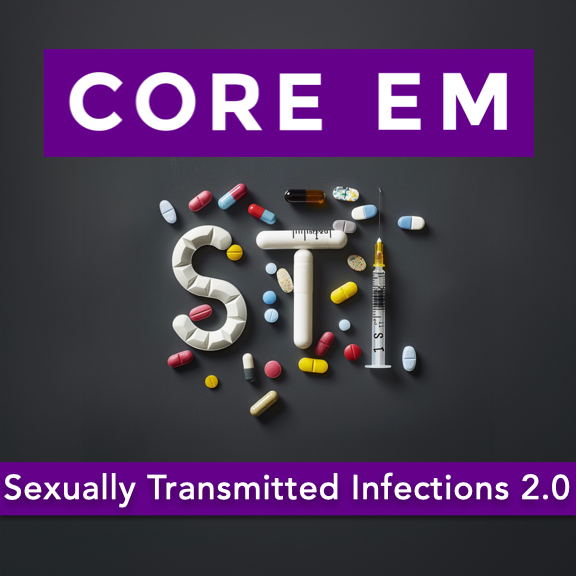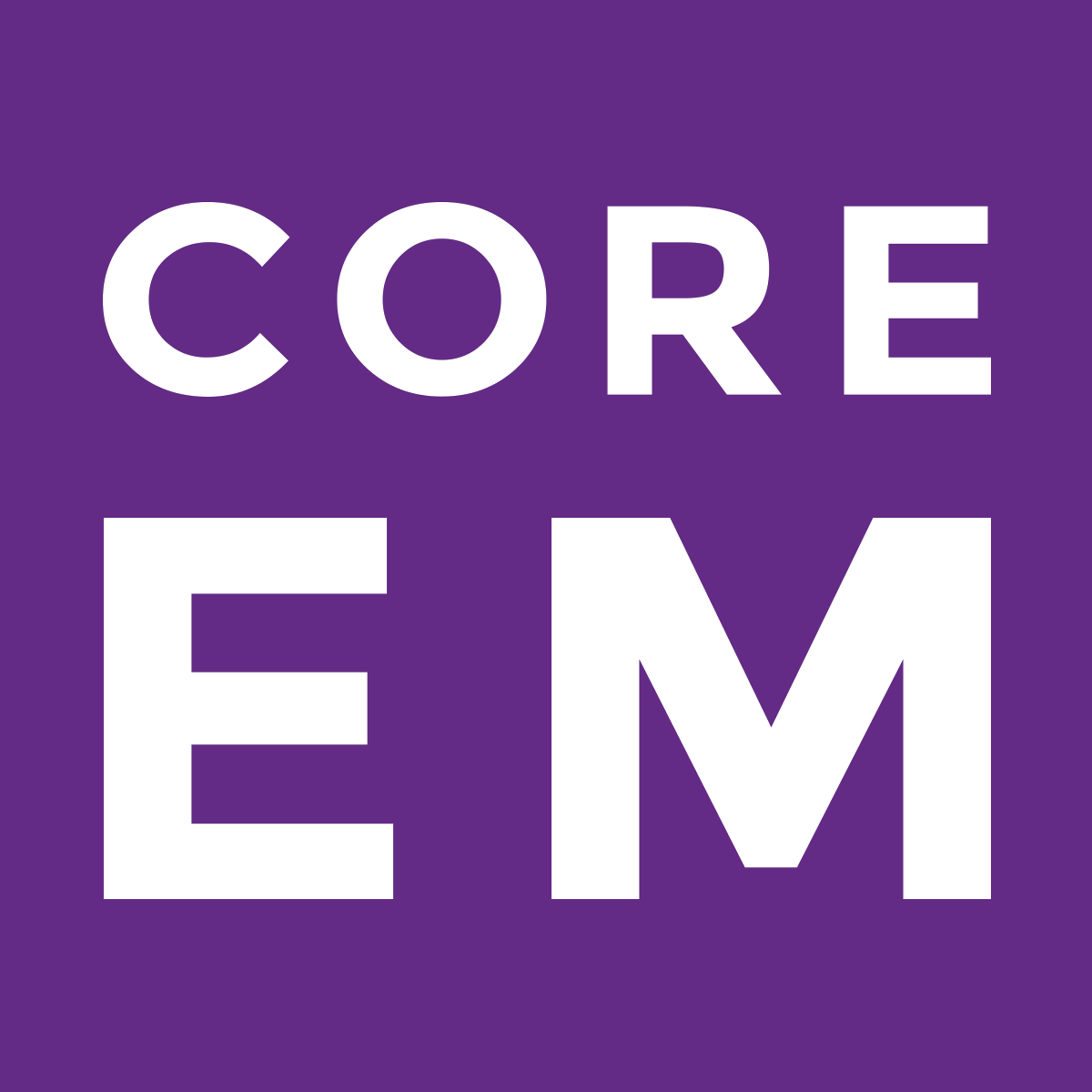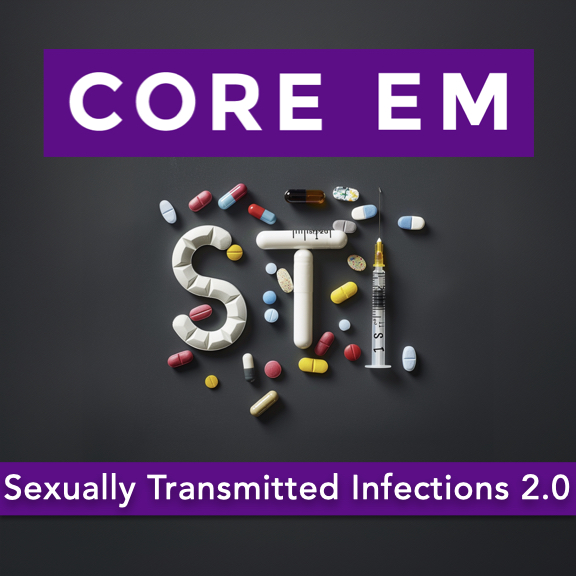
Episode 202: Sexually Transmitted Infections 2.0

Core EM - Emergency Medicine Podcast
Shownotes Transcript
We review Sexually Transmitted Infections and pertinent updates in diagnosis and management.
Hosts:
Avir Mitra, MD
Brian Gilberti, MD
https://media.blubrry.com/coreem/content.blubrry.com/coreem/Sexually_Transmitted_Infections_2_0.mp3
Download Leave a Comment Tags: gynecology, Infectious Diseases, Urology
Show Notes
Table of Contents
(1:49) Chlamydia
(3:31) Gonorrhea
(4:50) PID
(6:14) Syphilis
(8:08) Neurosyphilis
(9:13) Tertiary Syphilis
(10:06) Trichomoniasis
(11:13) Herpes
(12:49) HIV
(14:10) PEP
(15:13) Mycoplasma Genitalium
(18:00) Take Home Points
Chlamydia:
Prevalence:
- Most common STI.
- High percentage of asymptomatic cases (40% to 96%).
Presentation:
- Urethritis, cervicitis, pelvic inflammatory disease (PID), prostatitis, proctitis, pharyngitis, arthritis.
- Importance of considering extra-genital sites (oral and rectal infections).
Testing:
- Gold Standard: Nucleic Acid Amplification Test (NAAT) via PCR.
Sampling Sites:
- Endocervical or urethral swabs preferred over urine samples due to higher sensitivity.
- Triple-site testing (genital, rectal, pharyngeal) recommended for comprehensive detection.
Treatment Updates:
- Previous Regimen: Azithromycin 1 g orally in a single dose.
- Current First-Line Treatment: Doxycycline 100 mg orally twice daily for 7 days.
Alternatives:
- Azithromycin remains an option for patients unlikely to adhere to a 7-day regimen or for pregnant patients.
- Note: PID treatment differs and will be discussed separately.
Gonorrhea:
Presentation:
- Similar to chlamydia; can be asymptomatic.
- Symptoms include urethritis, cervicitis, PID, prostatitis, proctitis, pharyngitis.
Testing:
- Gold Standard: NAAT.
Sampling Sites:
- Endocervical swabs are more sensitive than urine samples.
- Triple-site testing is crucial to avoid missing infections.
Treatment Updates:
- Previous Regimen: Ceftriaxone 250 mg IM plus azithromycin 1 g orally.
- Current Recommendation: Ceftriaxone 500 mg IM single dose.
- Adjusted due to rising azithromycin resistance and updated pharmacokinetic data.
Co-Infection Considerations:
- High rates of chlamydia and gonorrhea co-infection (20% to 40%).
- CDC recommends empiric treatment for chlamydia when treating gonorrhea to prevent complications like PID and infertility.
Pelvic Inflammatory Disease (PID):
Etiology:
- Not solely caused by chlamydia and gonorrhea; about 50% of cases involve other pathogens like bacterial vaginosis (BV) organisms and anaerobes.
Treatment Changes:
Expanded Coverage Regimen:
- Ceftriaxone 500 mg IM once.
- Doxycycline 100 mg orally twice daily for 14 days.
- Metronidazole 500 mg orally twice daily for 14 days.
- Inclusion of metronidazole addresses anaerobic bacteria contributing to PID.
Syphilis:
Stages and Presentation:
Primary Syphilis:
- Painless chancre on genitals.
- Treatment: Penicillin G 2.4 million units IM single dose.
Secondary Syphilis:
- Rash (often diffuse), mucocutaneous lesions, nonspecific joint pain.
- Treatment: Same as primary syphilis.
Latent Syphilis:
- Asymptomatic phase; divided into early (<1 year) and late (>1 year).
Treatment for Late Latent:
- Penicillin G 2.4 million units IM once weekly for 3 weeks.
- Recommended when the timing of infection is unclear.
Neurosyphilis:
Can occur at any stage.
Symptoms include visual changes, severe headaches, neurological deficits.
Diagnosis: Requires lumbar puncture (LP) for confirmation.
Treatment: Admission for intravenous penicillin G.
Tertiary Syphilis:
- Rare, advanced stage with severe manifestations (e.g., gummas, cardiovascular complications, neurological signs).
- Treatment: Extended penicillin therapy similar to late latent syphilis.
Trichomoniasis:
Presentation:
- Often asymptomatic.
- In women: Vaginal discharge.
- In men: Urethritis.
Testing:
- Shift from wet mount microscopy to NAAT for improved detection.
- Swab samples preferred over urine for higher sensitivity.
Treatment Updates:
- Previous Regimen: Metronidazole 2 g orally in a single dose.
Current Recommendations:
- Women: Metronidazole 500 mg orally twice daily for 7 days.
- Men: Single 2 g dose remains acceptable.
Herpes Simplex Virus (HSV):
Types and Transmission:
- HSV-1 and HSV-2: Both can cause oral and genital infections.
- Increasing crossover between oral and genital sites.
Testing:
- Serum IgG testing not useful for acute diagnosis due to widespread prior exposure.
- Preferred Method: PCR testing from lesion swabs.
- Clinical Tip: If the lesion is characteristic, clinicians may start treatment without waiting for test results.
Treatment:
- Preferred Medication: Valacyclovir (Valtrex) for ease of dosing.
Dosage:
- Initial episode: 1 g orally twice daily for 7 to 10 days.
- Recurrence: 1 g daily for 5 days.
- Alternative: Acyclovir for cost considerations.
Human Immunodeficiency Virus (HIV):
Testing Limitations:
Window Periods:
- Fourth-generation tests have a window period of 2 to 4 weeks.
- Negative results during this period may not rule out recent infection.
Acute HIV Infection:
- Presents with flu-like symptoms: malaise, joint pains, fatigue.
Diagnosis Challenges:
- Standard HIV tests may be negative during the window period.
Options:
- Empiric treatment with follow-up testing.
- Order an HIV viral load test (more sensitive but expensive and delayed results).
Post-Exposure Prophylaxis (PEP):
- Timing: Initiate ideally within 72 hours of potential exposure.
- Duration: 28-day regimen.
Pre-Treatment Testing:
- Baseline HIV test to rule out existing infection.
- Renal and hepatic function tests to monitor for medication side effects.
Follow-Up: Reassess renal/hepatic function in 2 weeks.
Mycoplasma genitalium:
Recognition:
- Newly recognized STI by the CDC in 2021.
- Causes cervicitis and urethritis.
- Possible associations with PID and proctitis, but not definitively established.
Testing:
When to Test:
- Only in patients with persistent symptoms after standard STI testing and treatment.
- Not recommended for initial screening.
- Method: NAAT.
Treatment:
- Step 1: Doxycycline 100 mg orally twice daily for 7 days.
- Step 2: Moxifloxacin 400 mg orally once daily for 7 days.
- Addresses antibiotic resistance concerns and ensures comprehensive treatment.
General Management and Patient Counseling:
Partner Notification:
- Encourage patients to inform sexual partners for testing and treatment.
Medication Adherence:
- Emphasize the importance of completing the full course of prescribed medications.
Prevention Measures:
- Discuss the use of barrier protection (e.g., condoms) to prevent transmission and reinfection.
Follow-Up Care:
- Advise patients to return if symptoms persist, indicating possible infections like Mycoplasma genitalium.
Key Take-Home Points:
Chlamydia Treatment Update:
- Doxycycline 100 mg orally twice daily for 7 days is now first-line treatment for cervical infections.
- For epididymitis, extend doxycycline to 10 days.
Gonorrhea Treatment Update:
- Treat with a single 500 mg IM dose of ceftriaxone.
PID Management Update:
- Expanded antimicrobial coverage includes:
- Ceftriaxone 500 mg IM once.
- Doxycycline 100 mg orally twice daily for 14 days.
- Metronidazole 500 mg orally twice daily for 14 days.
- Expanded antimicrobial coverage includes:
Mycoplasma genitalium Recognition:
- Test in patients with persistent symptoms after standard treatment.
- Treat with doxycycline followed by moxifloxacin.
HIV Testing and PEP:
- Be aware of HIV test window periods; negative results may not rule out recent infection.
- Consider HIV viral load testing if acute infection is suspected.
- Initiate PEP within 72 hours for a 28-day course, ensuring clear discharge planning and patient support.
